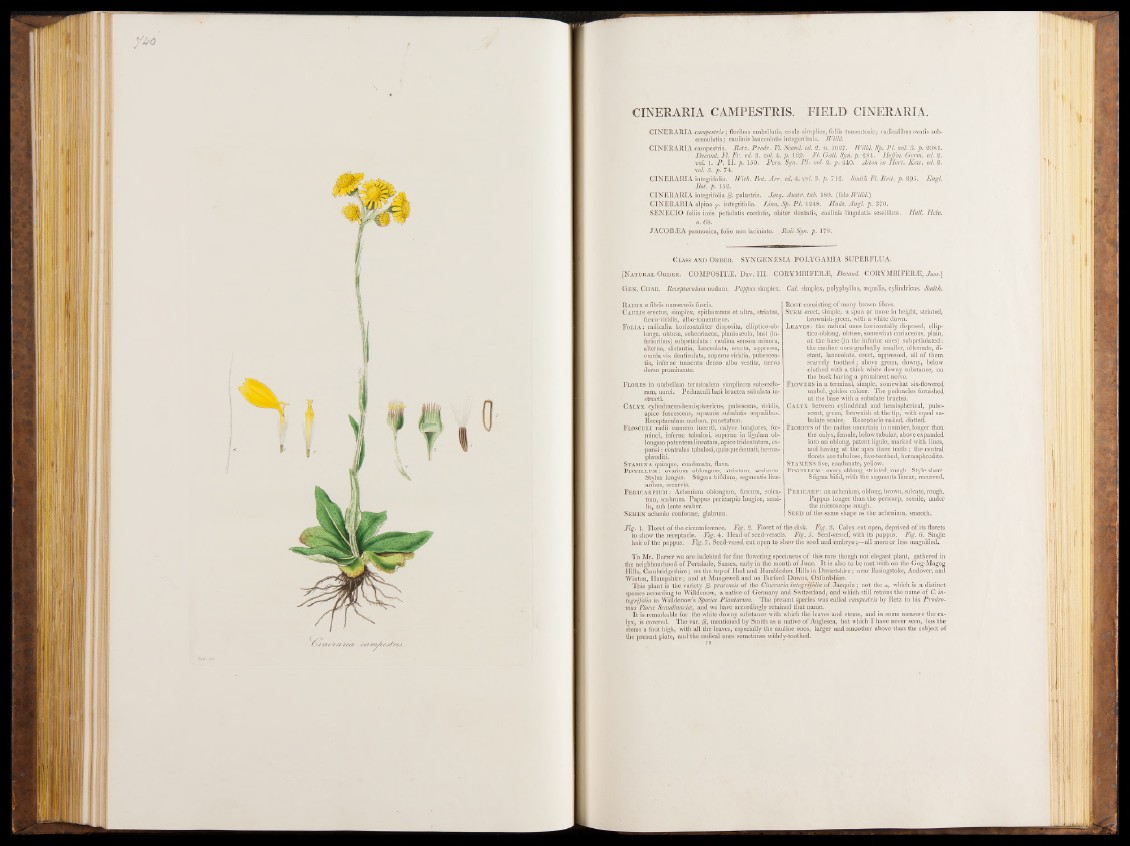
CINERARIA CAMPESTRIS. FIELD CINERARIA.
C INERARIA campcstris; floribus umbellatis, caulc simplice, foliis tomentosis; radicalibus ovatis sub-
crenulatis; caulinis lanceolatis integerrimis. Willd.
CINERARIA campestris. R etz. Prodr. FI. Scand. cd. 2. n. 109.7. Willd. Sp. PI. ml. 3. p. 2081.
Dccand. FI. Fr. ed. 3. ml. 4. p. 169- FI. Gall. Syn. p. 284. Hqffrn. Germ.-cd. 9.
ml. I. P . II. p. 150. Pers. Syn. PI. ml. 2. p . 44 0 ., Alton in Hort. Kero, ed. 9.
vól. 5. p. 74.
C INERARIA integrifolia. With. B'ot. A rr. ed. 4. vól. 3. p. 712. Smith FI. B rit. p. 895. Engl.
S o t. p. 152.
CINERARIA integrifolia ß . palustris. Jacq. Austr. tab. 180. (fide Willd.)
CINERARIA alpina y . integrifolia. Linn. Sp. P I. 1248. Finds. Angl. p. 370.
SENECIO foliis imis petiolatis cordatis, obiter dentatis, caulinis lingulatis sessilibus. Hall. Helv.
n. 68.
JACOBïEA pannonica, folio non laciniato. . Rail Syn. p. 178.
Class and Order. SYNGENE S IA POLYGAMIA SUPERFLUA.
[N atural Order. COMPOSIT/E. D iv . I I I . CORYMBIFER/E, Decand. CO RYM B IFER E , JussJj
Gen . Ciiar. Receptaculum nudum. Pappus simplex. Cal. simplex, polyphyllus, aequalis, cylindricus. Smith.
Radix e fibris numerosis fuscis.
Caulis erectus, simplex, spithamasus et ultra, striatus,
fusco-viridis, albo-tomentosus.
Folia: radicalia.horizontaliter disposita, elliptico-ob-
longa, obtusa, subcoriacea, planiuscula, basi (in-
ferioribus) subpetiolata: caulina sensim minora,
alterna, distantia, lanceolata, erecta, appressa,
omnia vix denticulata, supeme viridia, pubescen-
tia, inferne tomento denso albo vestita, nervo
dorso prominente. . -
Flores in umbellam terminalem simplicem subsexflo-
ram, aurei. Pedunculi basi bractea subulata in-
structi.
Calyx cylindraceo-hemisphasricus, pubescens, viridis,
apice fuscescens, squamis subulatis asqualibus.
Receptaculum nudum, punctatum.
FloscULI radii numero incerti, calyce longiores, fee-;
minei, inferne tubulosi, supeme in ligulam ob-
longam patentem lineatam, apice tridentatam, ex- i
pansi: centrales tubulosi, quinquedentati, herma- j
phroditi.
Stamina quinque, coadunata, flava.
PlSTILLUM: ovarium oblongum, striatum, scabrum.
Stylus longus. Stigma bifidum, segmentis line-
afibus, recurvis.
Perica rpium : Achenium oblongum, fuscum, sulcatum,
scabrum. Pappus pericarpio longior, sessi-
lis, sub lente scaber.
Semen achenio conforme, glabrum.
Root consisting of many brown fibres.
Stem erect, simple, a span or more in height, striated,
brownish-green, with a white down.
Leaves : the radical ones horizontally disposed, ellip-
tico-oblong, obtuse, somewhat coriaceous, plain,
at the base (in the inferior ones) subpetiolated :
the cauline ones gradually smaller, alternate, distant,
lanceolate, erect, appressed, all of them
scarcely toothed; above green, downy, below
clothed with a thick white downy substance, on
the back having a prominent nerve.
Flowers in a terminal, simple, somewhat six-flowered
umbel, golden colour. The peduncles furnished
at the base with a subulate bractea.
Calyx between cylindrical and hemispherical, pubescent,
green, brownish at the tip, with equal su-
bulate scales. Receptacle naked, dotted.
Florets of the radius uncertain in number, longer than
the calyx, female, below tubular, above expanded
into an oblong, patent ligule, marked with lines,
and having at the apex three teeth ; the central
florets are tubulose, five-toothed, hermaphrodite.
Stamens five, coadunate, yellow.
Pistillum : ovary oblong, striated, rough. Style short.
Stigma bifid, with the segments linear, recurved.
Pericarp : an achenium, oblong, brown, sulcate, rough.
Pappus longer than the pericarp, sessile, under
the microscope rough.
Seed of the same shape as the achenium, smooth.
Fig. 1. Floret of the circutnference. Fig. 9. Floret o f the disk. Fig. 3. Calyx cut open, deprived of its florets
to show the receptacle. Fig. 4. Head of seed-vessels. Fig. 5. Seed-vessel, with its pappus. Fig. 6. Single
hair of the pappus. Fig. 7. Seed-vessel cut open to show the seed and embryo;—all more or less magnified.
To Mr. Borrer we are indebted for fine flowering specimens of this rare though not elegant plant, gathered in
the neighbourhood of Portslade, Sussex, early in the month of June. I t is also to be met with on the Gog-Magog
Hills, Cambridgeshire; on the top of Hod and Hambledon Hills in Dorsetshire; near Basingstoke, Andover, and
Winton, Hampshire; and at Mungewell and on Burford Downs, Oxfordshire.
This plant is the variety /3. pratensis of the Cineraria integrifolia of Jacquin; not the a, which is a distinct
species according to Willdenow, a native of Germany and Switzerland, and which still retains the name o f C. integrifolia
in Wiudenow’s Species Plantarum. The present species was called campestris by Retz in his Prodro-
mus Flora Scandinavia, and we have accordingly retained that name.
I t is remarkable for the white downy substance with which the leaves and stems, and in some measure the calyx,
is covered. The var. (3, mentioned by Smith as a native of Anglesea, but which I have never seen, has the
steins a foot high, with all the leaves, especially the cauline ones, larger and smoother above than the subject of
the present plate, and the radical ones sometimes widely-toothed.